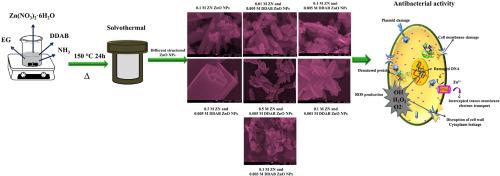Microbial Pathogenesis ( IF 3.8 ) Pub Date : 2020-05-31 , DOI: 10.1016/j.micpath.2020.104290 Insoo Kim 1 , Karthika Viswanathan 1 , Gopinath Kasi 1 , Kambiz Sadeghi 1 , Sarinthip Thanakkasaranee 1 , Jongchul Seo 1

|
Solvothermal synthesis was used to investigate the formation of zinc oxide (ZnO) nanoparticles (NPs). A series of ZnO NPs was synthesized with different relative ratios of didodecyldimethylammonium bromide (DDAB) and zinc nitrate (ZN). The variation in the molarity influenced the crystallinity, size, and morphology of the obtained ZnO NPs. X-ray diffraction, Fourier-transform infrared spectroscopy, field-emission scanning electron microscopy, high-resolution transmission electron microscopy, and zeta potential analysis were used to study the characteristic features of the ZnO NPs. The ZnO surface charge, size, and morphological structure were highly reliant on the concentrations of DDAB and ZN. With increasing relative ratio of DDAB to ZN, the particle size of ZnO NPs decreased and the surface charge increased to higher positive value. The ZnO NPs synthesized with cationic liquid DDAB presented enhanced performance in preventing the growth of Staphylococcus aureus (S. aureus) and Escherichia coli (E. coli) strains. The antibacterial activity of ZnO NPs have direct contact with the microbial cell wall resulting in destruction of bacterial cell integrity, release of antimicrobial Zn2+ ions, and induce cell death. This is due to the positively charged smaller ZnO NPs, prepared with DDAB cationic surfactant, effectively acting as an antimicrobial agent against food-borne pathogenic bacteria.
中文翻译:

对抗细菌病原体的表面带正电的氧化锌纳米粒子的制备和表征。
溶剂热合成用于研究氧化锌(ZnO)纳米粒子(NPs)的形成。以十二烷基二甲基溴化铵(DDAB)和硝酸锌(ZN)的不同相对比例合成了一系列ZnO NP。摩尔浓度的变化影响所获得的ZnO NPs的结晶度,大小和形态。用X射线衍射,傅立叶变换红外光谱,场发射扫描电子显微镜,高分辨率透射电子显微镜和ζ电势分析来研究ZnO纳米颗粒的特征。ZnO的表面电荷,大小和形态结构高度依赖于DDAB和ZN的浓度。随着DDAB与ZN相对比例的增加,ZnO NPs的粒径减小,表面电荷增加至较高的正值。金黄色葡萄球菌(S. aureus)和大肠杆菌(E. coli)菌株。ZnO NPs的抗菌活性与微生物细胞壁直接接触,导致细菌细胞完整性破坏,抗菌Zn 2+离子释放并诱导细胞死亡。这是由于用DDAB阳离子表面活性剂制备的带正电的较小ZnO NP有效地充当了对食源性致病细菌的抗菌剂。


























 京公网安备 11010802027423号
京公网安备 11010802027423号